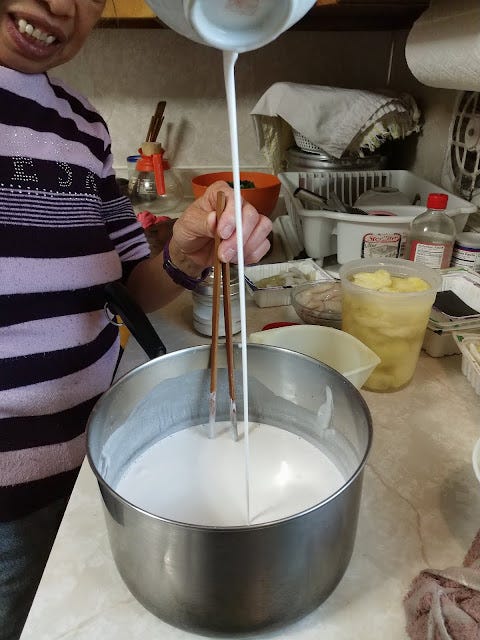Diāng-biĕng-gù, 锅边糊
A second look at one of our favorite comfort foods
As with many families, we have plenty of healthy rivalries. A common one is for all the aunts to ask the kids who cooked it better. In this recipe, we revisit a recipe for Diāng-biĕng-gù, 锅边糊, this time from our Aunt Kim. Compared to the previous recipe, it mostly just features better pictures. The devil is in the details (and pouring technique).
Ingredients
1 lb bag of rice flour (usually a clear bag with red print)
1 cup of water
salt
green onions, aka scallions
cabbage
mussels [optional]
This can be any desired seafood for taste, such as clams or shrimp
chicken broth
We make our own broth with chicken or pork bones and salt that is slow cooked for 4 hours. Additional vegetables can be added for flavor.
Cooking Tools
wok
large bowl
large pot
Steps
Wash and cut your vegetables. In this case, we used onions, napa cabbage, and humongous home-grown scallions.
Mix the whole bag of rice flour with 1/4 teaspoon of salt.
Create a crater in the middle of the rice flour and pour in 1 cup of water. Mix the water and flour until the mixture is at the desired consistency.
You may need to add more water. How do you know how much water to add? You want it to be relatively thin, but still form a continuous stream (without breaking) when you pour it.
Here's a video:
Heat up a wok. Add some oil. We'll start by stir-frying the onions. They take longer to cook.
Then add in the cabbage.
Finally add scallions.
Once they're relatively cooked, pour 2 scoops of chicken broth into the wok. Cover the wok to boil.
Steam for a few minutes.
Then remove the vegetables and set it aside.
Pour all the remaining broth into the wok and bring it to a boil. We're just trying to heat it up for later.
Then remove half of the broth from the wok which will later be used to maintain the consistency of the noodles.
Here comes the tricky part. With some broth remaining in the wok, you want to heat up the wok to a high temperature. The edges of the wok need to be hot. Then in a fluid motion, pour a bowl full of the rice batter around the dry side of the wok to cook it into a noodle. You don't want the wet flour to touch the soup, or the soup gets goopy.
Here's a video of the whole process
Wait for the noodle to cook. You can cover the wok if it helps. Then push the noodle into the broth. Noodles should only be pushed into the broth when it is boiling. The key is to have these solid flakes of noodle.
If the soup becomes too dense with noodles, scoop it out into a pot and start with some fresh broth that you previously set aside. Continue until you use all the batter mixture. When you’re done making all of the noodles, mix all of the vegetables, noodles, and soup and bring it to a boil. Then transfer to a big pot.
And you're done! You’ll want to salt it to taste at this point.


























